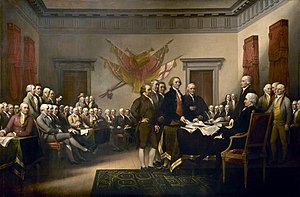
Back Дэклярацыя незалежнасьці (карціна) BE-X-OLD Declaració d'Independència (John Trumbull) Catalan Deklarace nezávislosti (obraz) Czech Declaration of Independence (Trumbull) Danish Declaration of Independence (Trumbull) German Declaración de Independencia (John Trumbull) Spanish La Déclaration d'indépendance (Trumbull) French Անկախության հռչակագիր (նկար) Armenian Deklarasi Kemerdekaan (Trumbull) ID Declaration of Independence Italian
| Declaration of Independence | |
|---|---|
 | |
| Artist | John Trumbull |
| Year | commissioned 1817; purchased 1819; date of creation 1818; placed in U.S. Capitol rotunda 1826 |
| Medium | Oil-on-canvas |
| Dimensions | 3.7 m × 5.5 m (12 ft × 18 ft) |
| Location | U.S. Capitol, Washington, D.C., U.S. |
Declaration of Independence is a 12-by-18-foot (3.7 by 5.5 m) oil-on-canvas painting by the American artist John Trumbull depicting the presentation of the draft of the Declaration of Independence to Congress. It was based on a much smaller version of the same scene, presently held by the Yale University Art Gallery.[1] Trumbull painted many of the figures in the picture from life, and visited Independence Hall to depict the chamber where the Second Continental Congress met. The oil-on-canvas work was commissioned in 1817, purchased in 1819, and placed in the United States Capitol rotunda in 1826.
The painting is sometimes incorrectly described as depicting the signing of the Declaration of Independence. The painting shows the five-man drafting committee presenting their draft of the Declaration to the Congress, an event that took place on June 28, 1776, and not its signing, which took place mainly on August 2.[2]
The painting shows 42 of the 56 signers of the Declaration; Trumbull originally intended to include all 56 signers but was unable to obtain likenesses for all of them. He also depicted several participants in the debate who did not sign the document, including John Dickinson, who declined to sign. Trumbull had no portrait of Benjamin Harrison V to work with, but his son Benjamin Harrison VI was said to resemble his father, so Trumbull painted him instead. Similarly, Trumbull painted Rufus Hopkins, who resembled his father Stephen Hopkins, for whom no portrait was available. As the Declaration was debated and signed over a period of time when membership in Congress changed, the men featured in the painting never were in the same room at the same time.
- ^ Cite error: The named reference
yale69was invoked but never defined (see the help page). - ^ John Hazelton, "The Historical Value of Trumbull's - 'Declaration of Independence' ", The Pennsylvania Magazine of History and Biography - Volume 31, (Historical Society of Pennsylvania, 1907), 38.